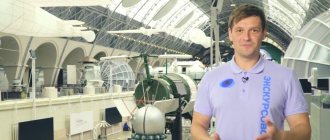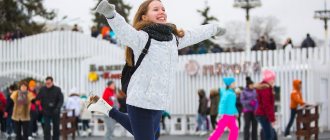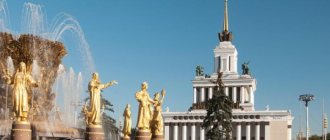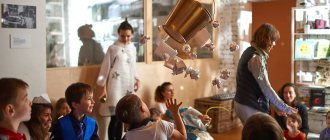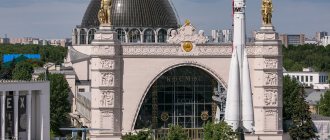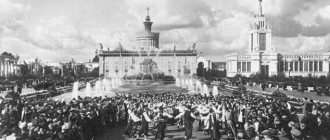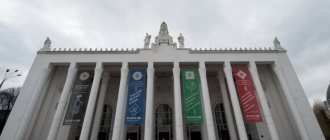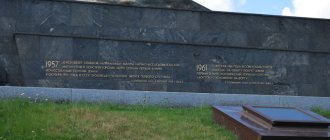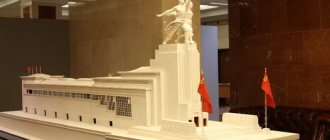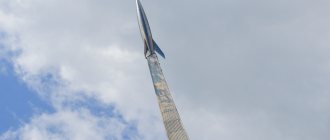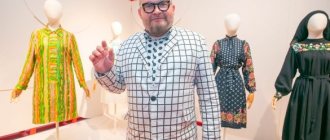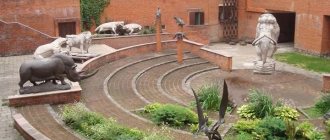Date: 1 Feb, 2021 Author: Elena Category: Weekend walks, Walks around Moscow
VDNKh (or VVC) is one of the main places to visit for tourists, guests of the capital and residents of Moscow. Many people come to VDNKh not only for walks, taking photographs at the fountains or visiting the skating rink in winter. Most people come to visit the pavilions of VDNKh (formerly called the All-Russian Exhibition Center), famous back in the distant times of the USSR.
Today VDNKh is actively reconstructed and modified. For example, by the summer of 2021, it is planned to open an amusement park at VDNKh, which can be visited all year round; the old attractions were dismantled already in 2021. So we think that the opening of new attractions will be a loud and expected event, but most likely less pretentious and not as controversial as the opening of Zaryadye Park.
In the meantime, you can visit attractions for children and adults:
- in Skazka Park (metro station Krylatskoye), there is also a Dinopark,
- in Skolniki (there is a panda rope park nearby),
- attractions in Izmailovsky Park,
- in Friendship Park at the River Station,
- in Kolomenskoye and Kuzminki,
- in the amusement park on Poklonnaya Gora,
- in a small park on Skhodnenskaya near the river.
But, let’s not deviate from the topic, today we will tell you in more detail about the most interesting and visited VDNKh pavilions, which will be interesting for adults and children to visit, we will tell you about their work schedule and prices.
VDNKh work schedule in 2019
Starting from 2015, VDNH switched to 24-hour opening hours. In the summer, many people roller-skate, skateboard and bicycle here at night.
Pavilions operate according to their own schedules, more on that below.
Cafes at VDNKh operate:
- in summer from 10.00 to 23.00,
- in winter from 10.00 to 22.00.
Stationary toilets are open to the public from 10.00 to 24.00.
To make it clear where each pavilion is located, we have attached several maps. You can save any map to your computer and print it out. We don't feel sorry!
Notes
- Agricultural exhibitions
// Great Soviet Encyclopedia. - M.: Soviet Encyclopedia. 1969-1978. - Exhibition ensembles of the USSR. 1920-1930s: materials and documents. - M.: Galart, 2006. - 468 p. — ISBN 978-5-269-01050-2.
- Unpreserved pavilions of VDNKh.
- Gerasimovich P. M.
Arlow Alexander Mikalaevich // Encyclopedic literature and history of Belarus. - Mn.: BelEn, 1984. - T. 1. - P. 167. - Bela Whitz.
- Kashuba-Volvach O., Storchai O. Master of monumental painting by M. Boychuk in Pershodzherelakh. The Sorrows of Oksana Pavlenko and Vasil Sedlyar // Educational Mystery - 2008. - No. 4. - P. 40-42; 2009. - No. 2. - P. 24-29; 2009. - No. 3. - P. 132−135.
- Stupin V.
About the architecture of the All-Union Agricultural Exhibition // Architecture of the USSR. - M.: State Publishing House of Literature on Construction and Architecture, 1954. - No. 9. - P. 1-17. - VSKhV―VDNKh―VVTs. Science and life.
- VDNKh, pavilion 18.
- Guests are welcome here. “Belarus-Russia Union”, No. 705 (29).
VDNH pavilions on the map
Maps enlarge when clicked
The diagram shows the working pavilions of VDNKh
If you are in Moscow for the first time and decide to visit VDNKh, we recommend setting aside a whole day, or maybe even two days, because... The territory is huge, and there are a lot of pavilions.
Must-see:
- Pavilion Space (No. 32),
- Moskvarium (No. 23),
- Robot Station pavilion (No. 2),
- pavilion with 3D attractions and the Museum of Illusions (with children),
- Polytechnic Museum (No. 26),
- Health pavilion (No. 13),
- Pavilion My History (No. 57),
- pavilion Smart City (No. 461),
- Pavilion Model of Moscow.
Well, now we’ll briefly tell you about each pavilion separately, their work schedule and entrance fee.
To make it more convenient to check the VDNKh map, we’ll start our review of the pavilions from the main entrance and go in a circle, clockwise.
Fairs of Belarusian goods at VDNH in Moscow will replace showrooms
The Belarusian pavilion at VDNKh in Moscow is rightfully considered one of the most original in its architecture and is one of the cultural monuments of national importance. Of the pavilions of the former Soviet republics, it is now practically the only one that has generally retained its original function: to demonstrate achievements in the economy, science and technology of the now independent Belarus. A little less than two years ago, a large-scale reconstruction of the pavilion with the participation of the Belarusian side was completed, which lasted almost 10 years and returned it to its original historical appearance. BELTA's correspondent talked to the General Director of the Belarusian Trade Exhibition and Information and Marketing Center CJSC Gennady Romanenko about how the Belarusian house lives today at the main Russian exhibition.
— Gennady Mikhailovich, is the center you head the management company of the Belarusian pavilion?
- Actually yes. This is an organization that, according to the plan, should be involved in the maintenance of the pavilion and on its basis create conditions for the development of mutually beneficial types and areas of cooperation between Russian and Belarusian enterprises. Moreover, not only in the export of Belarusian products to Russia, but also in the supply of necessary products, raw materials, and materials to Belarus.
The pavilion is owned by the Russian Federation. We lease it for 50 years. And our center was 100% established by Belarusian enterprises subordinate to the government of the country. The main shareholder is the Belresursy concern. The board of directors represents the Minsk City Executive Committee, as well as large state-owned enterprises.
— Are business entities willing to cooperate with you?
— In different ways, depending on how powerful the business entity is. There are large Belarusian enterprises that have long had their distribution network in Russia. And some of them believe that they do not need our services. And there are enterprises that are just developing and do not have access to the Russian market; they are making some tentative attempts. Such enterprises are willing to contact us. In particular, we now have a Belarusian company represented in our pavilion, which is engaged in sewing special clothing for medical purposes. They are happy to exhibit with us for the third time in a month, they like it. These are the kind of enterprises, not very large ones, that are interested in our services.
Now more and more Belarusian enterprises are turning to us, with whom Russians do not want to work due to the fact that they are foreigners to them. Because of this, questions arise regarding VAT, payment confirmation, etc. In these situations, we also lend a hand, buy the products ourselves and supply them, naturally, without VAT.
— What other difficulties arise, perhaps of a regulatory nature, that you cannot solve on your own?
— There are serious difficulties with access to auctions and competitions held by Russian electronic trading platforms. For example, on one large platform, no matter how hard we try to participate in its competitions, we do not pass. Because any agency, the same Gazprom, when holding its auction, includes in the conditions some clause that is fundamental to winning, and it is obviously discriminatory for us. We tried to resolve the situation through the CIS Economic Commission, we have all the documents stating that we should be subject to the same requirements as Russian enterprises, and the same benefits should be extended. But it’s still difficult to break through. There is an administrative resource and we cannot overcome it.
On the other hand, it has now become difficult to work with Belarusian regions: many do not see the economic feasibility of participating in the events we conduct. I can somewhat understand them, since I myself worked in the meat and dairy industry for a long time and participated in exhibitions in Moscow on behalf of Belarusian enterprises. And I often thought exactly the same way as my Belarusian colleagues think now. But now the situation has changed somewhat. This applies to many Belarusian enterprises that have their distributors in Russia and supply products to network buyers - Auchan, Dixy, Karavan, Magnit, etc., having concluded contracts with them on very strict conditions. For example, Kommunarka or Spartak bought several assortment items out of a hundred or even more from such a network. But the likelihood that a buyer will choose Belarusian sweets on a multi-meter rack with a huge assortment is very small. Because they don’t have money for advertising; advertising on Russian TV channels is very expensive. In our pavilion we have the opportunity to put up a banner on which to indicate to buyers: today you tried this product, but you can also buy it at Auchan, Dixie, and Magnit. This is free advertising for them.
— How many visitors a day pass through the pavilion, is there such statistics?
— We installed counters some time ago, and they showed that on Saturdays from 6 thousand to 11 thousand people come to us, on Sundays - from 5 thousand to 8-9 thousand. On weekdays there are from 1.5 thousand up to 3.5 thousand visitors. Now these numbers are higher: starting from Friday, we have a full house, the traffic is very high.
— While I was going to this interview, every few minutes throughout the entire territory of VDNKh there were announcements about the Belarusian pavilion with a brief retelling of what Muscovites and guests of the Russian capital could buy there. Is this advertising effective, who pays for it?
- We pay, and a lot. But I think it is very effective. This advertisement has been running for three months now. During this time, we saw a very serious increase in sales volumes.
— How do you plan to develop?
— The trade that we have is largely a necessary measure. We must maintain this pavilion. Now it represents 160 enterprises: mainly light industry, food industry, meat and dairy industry. In the future, we plan to reduce their number by half, leaving the best, but organizing accessible showrooms for each enterprise with the right to conclude contracts. So that not just retail trade is carried out, but there is an opportunity to enter into contracts for small wholesale or large wholesale supplies. So that a Russian entrepreneur or a representative of an enterprise does not have to travel to Belarus, but here he can not only see the product in person, but also look at the price lists and make a transaction.
— Are there already examples of such interaction?
- Yes, I have. The pavilion houses showrooms of famous Belarusian cosmetics companies. Such work has already been established with them. We have tested this scheme, we see that it works, and we are ready to offer it to others.
— Besides trade, are there any other events held in the pavilion?
— Together with the Business and Cultural Complex of the Belarusian Embassy in Russia, we hold exhibitions for all our main national holidays. We cooperate with the Belarusian State Museum of the History of the Great Patriotic War, art galleries of Belarus. Cooperation has been established with the Union of Cinematographers of Belarus: this year we held an exhibition of historical posters of Belarusfilm films. Such events, which are completely non-commercial, attract additional audiences.
We have a large representation of the Belarusian tourism industry. There is a desire to attract medical institutions here to help promote Belarusian healthcare services. For example, in Belarus there are very good clinics that perform vision correction operations. In Russia, of course, such operations are also carried out, but the prices are not comparable. And in the field of oncology in Russian clinics the prices are fabulous, and this service is in demand. We are ready to help.
— Last week, the Belarusian pavilion, like the pavilions of other CIS countries at VDNKh, was visited by deputy prime ministers of the Commonwealth states. What experience can you learn from colleagues from the former Soviet republics?
“I think we are a little ahead of others.” Now, besides us, only Armenia has an operating pavilion. But it is somewhat specific, it has a more commercial orientation. Therefore, we can rather share our experience. Although we can adopt some things too. For example, experience in organizing interior design.
The most important thing we do is advertise Belarusian products and show their high quality. I am sure that if a person bought some product in the Belarusian pavilion and he likes this product, no one will convince him that they do something poorly in Belarus.
Moscow,
Eduard PIVOVAR,
BELTA.-0-
Subscribe to us on Yandex.Zen, Telegram and Viber!
Tags
Belarus exhibition Moscow
Working pavilions at VDNKh
Central Pavilion 1
The pavilion is located on the central alley of VDNKh between the Lenin monument and the Friendship of Peoples fountain. Currently, pavilion No. 1 is under reconstruction and is closed to the public. But the façade of the building has been completely restored and its golden spire shines brightly in the sun.
During Soviet times, the central pavilion hosted exhibitions of the national economy of the USSR and exhibitions dedicated to individual periods of the Soviet state. The last exhibition took place in December 2015 and was dedicated to VDNKh artists.
Robot station (pavilion 2)
If you go to the left from the central pavilion and the Friendship of Peoples fountain, you will see a tall, snow-white pavilion No. 2 with large columns, where a modern interactive exhibition with exhibits - robots from 20 countries of the world - is taking place.
The robot station operates from 11.00 to 20.00 daily.
Ticket prices:
- adult – 550 rub. (weekdays) / 650 rub. (weekend)
- children (3-14 l) – 450 rub. (weekdays) / 490 rub. (weekend)
- students, pensioners – 390 rub.
On the official website of the pavilion you can buy tickets with a 20% discount.
Of course, it is better to come here with children of preschool and primary school age.
Among the interesting exhibits are a robot solving a Rubik's cube, a beggar robot and a makeup artist.
Seeds (Pavilion 7)
Old Semyon Pavilion (closed for renovation)
Temporary pavilion Semyon, a cat exhibition is also taking place here
The ancient VDNKh pavilion is now closed for renovation, but seeds can be purchased in the neighboring pavilion No. 536. There is also a temporary cat exhibition located here.
Pavilions No. 7 and No. 536 are located near the southern entrance to VDNKh.
Seeds pavilion opening hours:
- Monday to Friday: 9.00-17.30.
- Saturday and Sunday are days off.
Pavilion Health (No. 12)
Currently, the Health Pavilion is located in the gray cubic building No. 12.
The pavilion can be easily found, opposite the Stone Flower fountain on the left side.
They mainly sell herbs, honey, Chinese medicines and orthopedic products. You can do an examination of the blood vessels of the legs and feet for the presence of flat feet, bone density and heart function without waiting in line or making an appointment.
Free diagnostic promotions are held annually.
Opening hours:
Every day from 10.00 to 19.00.
Prices for examinations:
- leg vessels – 500 rub.
- foot diagnostics – 400 rub.
- Bone density determination is free.
Also in the building there is a small pavilion with musical instruments and an inexpensive cafe with home cooking (tested - the food is delicious).
Pavilion Healthy Moscow
All summer long, a new pavilion will be open at VDNKh, where you can check your health for free, donate blood, do an ultrasound, check your eyesight, etc.
Opening hours of the Healthy Moscow pavilion: from 8:00 to 22:00 daily, seven days a week and no lunch break.
To undergo the examination, you must have the following documents with you:
- passport (or copy of passport) or driver's license,
- Moscow compulsory medical insurance policy, only if you are not assigned to a clinic.
Pavilion location: the Healthy Moscow pavilion is located at VDNKh next to the Chess Club (from the main entrance you need to go to the right towards the Northern Entrance Arch). Look for a white rectangular house, as in the photo:
Additional information on the work of the pavilion can be found by phone from 8:00 to 17:00 on weekdays.
In which parks you can also check your health for free, see our article: Healthy Moscow Pavilions: addresses on the map.
Pavilion Belarus (No. 18)
A large building with beautiful columns is located next to the Health Pavilion.
Inside you will find goods from Belarus: honey, textiles, cosmetics, food, Belarusian ice cream.
Opening hours:
- Weekdays – from 10.00 to 19.00.
- Weekends and holidays – from 10.00 to 20.00.
Pavilion Ukraine (No. 58)
In our subjective opinion, it is one of the most beautiful buildings at VDNKh. The pavilion is located on the central alley, right behind the Stone Flower fountain.
Currently, the pavilion is closed to the public, restoration work is underway.
In Soviet times, the pavilion presented the achievements of crop production and livestock farming, as well as the achievements of Ukrainian industry.
Pavilion Russia, My History (No. 57)
A modern, elongated building made of metal and glass, located immediately behind the Ukraine pavilion on the right side.
There are exhibitions dedicated to the Rurikovichs, the Romanov family and the history of Ancient Rus' in general. There are 17 halls in total in the pavilion, including a cinema hall.
All exhibits in the pavilion are interactive and multimedia, made using modern technologies. Children of preschool and primary school age may be bored.
Schedule:
- Tuesday – Sunday – from 10.00 to 20.45.
- Monday – closed.
Ticket prices (prices taken from the official website of the Russia pavilion):
Museum of Optical Illusions (Pavilion 55)
The Museum of Illusions is located next to the My History pavilion and the Cosmos pavilion. This pavilion can be attributed more to entertainment events. Children of school and preschool age will definitely like it here.
At the Museum of Illusions you can visit the following entertainment attractions:
- Mirror labyrinth – 300 rub.
- Museum of Illusions – 350 rub.
- Butterfly garden – 300 rub.
- Inverted city – 500 rub.
- Break the dishes (6+) – 300 rub.
- The Giant's House - 350 rub.
- Glass labyrinth – 300 rub.
- Ribbon maze – 300 rub.
- Labyrinth of Fear (12+) – 350 rub.
- Prison escape (6+) – 300 rub.
- Inside a person - 350 rubles.
Children under 5 years old enter free of charge.
There are promotions:
- tickets for all attractions cost 2000 rubles. On the official website – 1450 rub.
- ticket for any 5 attractions – 1000 rub.
Schedule:
- Weekdays – from 10.00 to 19.00.
- Weekends and holidays – from 10.00 to 20.00.
Pavilion Space (No. 32)
This is one of the most interesting pavilions at VDNH. For more information about opening hours and ticket prices, as well as many photographs of space exhibits, see our article.
Adults and high school students will definitely enjoy the Space pavilion.
Polytechnic Museum (No. 26)
One of the parts of the Polytechnic Museum is located in pavilion 26 at VDNH next to the Space Pavilion.
We strongly recommend visiting this museum; it will be interesting for adults and children of middle and high school age. There are a lot of interactive exhibits; master classes and activities are held for children.
Schedule:
- Tuesday–Friday: 11.00–19.00
- Saturday–Sunday: 11.00–21.00
- Monday is a day off.
Ticket prices:
- adults – 350 rub. weekdays, 400 rub. weekend.
- pensioners, disabled people III gr. – 150 rub. weekdays, 200 rub. weekend.
- students - 200 rub. weekdays, 250 rub. weekend.
Moskvarium (pavilion 23)
A modern new pavilion contains several locations, here you can:
- visit a large aquarium,
- watch a show with dolphins and killer whales,
- swim with dolphins,
- visit the interactive exhibition.
We would like to note right away that the show is not a simple circus show, where dolphins and fur seals take turns executing commands; here all performances take place in the form of a performance with a storyline. It will be interesting for both adults and children.
The only negative is the cost of tickets.
Aquarium prices:
Prices for the show are even more expensive: from 1500 to 5000 rubles. (See the official website for more details).
You can buy a ticket for the show on the website or at the Moskvarium box office.
You can get to the Moskvarium pavilion by a free minibus that runs every 15 minutes. The stop is located on the right side of the main alley, if you stand with your back to the main entrance of VDNH.
Smart City Pavilion (No. 461)
The robot tells you when your child entered and left school.
Human identification system. Determines gender, age and location
Part of the pavilion with Smart City exhibits
Another modern pavilion at VDNKh, dedicated to new achievements and mobile developments in Moscow. The project is supported by the Moscow government, and therefore a visit to the pavilion and a 1-hour excursion are free !
Opening hours: daily from 11.00 to 19.00.
Before the tour begins, you will be asked to complete a short registration on a tablet, where you will receive an electronic card, which will be needed to manipulate some of the exhibits in the exhibition.
Naturally, all the exhibits are multimedia, there are several 3D simulators: for example, you can ride in a subway driver’s cab, see how video cameras work and find any house through real-time video surveillance. Draw in 3D format, learn about medical advances, etc.
The pavilion is located on the right side of VDNH (from the Ukraine pavilion, go right along the wide roadway to the circle).
Pavilion Model of Moscow
The pavilion is located next to the Smart City pavilion.
Here you can see the layout of Moscow, the entire city center in great detail from different angles and at different times of the day.
The model of Moscow was created up to the Garden Ring, everything was done in great detail: the lights are on in the houses, there are cars and trains on the roads, only there are not enough people
Once an hour, a lighting show begins for 5 minutes: different areas of Moscow are illuminated in the dark, poems accompanied by classical music are played in the speakers
3D printer creating houses for a model of Moscow
The blanks are assembled by hand
And this is a short video of what the Moscow panorama looks like live:
Entry cost: free.
Opening hours: from 10.00 to 20.00 daily, except Monday.
Pavilion 75
A huge exhibition pavilion at VDNKh. The building has been completely restored, but is currently closed to the public.
The pavilion is located on the right side of the main entrance of VDNH, located immediately after the dismantled amusement park.
The modern glass building with the monumental concrete gates of the past Northern Entrance of VDNKh looks a little strange and absurd.
Well, and a couple more pavilions, which are decorated with the scale of the buildings, these are:
Pavilion 71 – Nuclear Energy
A monumental building with the symbols of the USSR - the hammer and sickle, is located on the right side of the main entrance of VDNKh near the Friendship of Peoples fountain. Currently, the external façade has been restored, and renovation work is underway inside the building.
Pavilion Armenia (No. 68)
The beautiful snow-white building is located next to pavilion 71. It currently houses the Ararat restaurant and tasting room.
Pavilion 67 (Karelia)
The interesting building contrasts sharply with the nearby Armenia and…
with its wooden roof and carved door. Currently, the pavilion hosts the exhibition “The Ball is Round, the Field is Flat,” dedicated to the chronicles of Russian football.
Ticket price:
- adult - 300 rub.
- schoolchildren, students and pensioners – 100 rubles.
- children under 6 years old – free.
Operating mode:
- Tuesday – Sunday: from 11.00 to 22.00.
- Monday is a day off.
Pavilion 66 (Culture)
Another monumental building with a snow-white rotunda is dedicated to the Uzbek SSR. In Soviet times, an exhibition was held here, the main theme of which was cotton and sericulture; there was also an Uzbekvino store and an Uzbek teahouse restaurant.
Currently, pavilion 66 is under reconstruction.
And the pavilion is located immediately behind the Karelia pavilion.
What else to do at VDNKh?
VDNKh hosts thematic exhibitions every week, and every month there is a cat exhibition (you can buy yourself a purebred kitten from breeders or just pet and play with the cats). You can ride a bike, take a walk in the Botanical Garden, or climb into a real Yak-42 plane. In winter, try your hand at the largest skating rink in Moscow.
From 05.07 to 21.07.2019, the 5th international festival Inspiration will be held at VDNKh. Many performances will be free to attend. For more information about the festival program, see here.
All year round at VDNKh you can visit individual and group excursions:
"A city to remember." 458. VSKhV-VDNKh USSR. Byelorussian SSR and Moscow region
April 20, 2021 Photo project “City in Memory”. 458. VSKhV-VDNKh USSR. Byelorussian SSR and Moscow region
In the wonderland of the All-Russian Agricultural Exhibition, all sorts of geographical incidents happen: Armenia may end up in Siberia, and the Moscow region will become a neighbor of Ukraine. At the 1954 exhibition, only the three Baltic republics stayed in a tight, isolated group, and the architects arranged the rest of the republican pavilions rather arbitrarily. The main alley of the exhibition near the Stone Flower fountain was decorated with pavilions representing the achievements of the Byelorussian SSR, Ukrainian SSR and the Moscow, Ryazan, and Tula regions.
The first version of the pavilion of the Byelorussian SSR (architect G. Milchuk) was built in 1937, it was supposed to house several expositions - the Byelorussian SSR, Western, Kalinin, Ivanovo and Yaroslavl regions. In the same year, it was decided to build separate buildings for the regions, but the already built pavilion did not meet the expectations of the selection committee and was rejected.
See old photographs: Pavilion of the Belarusian SSR. 1937: https://pastvu.com/p/65200
See old photographs: Pavilion of the Belarusian SSR. 1939: https://pastvu.com/p/79497
In 1938-1939, not some peasant hut, but a solid building with a portico (architects V. Simbirtsev and V. Barkhin) rose in its place. The snow-white columns of the portico combined perfectly with the decorative faience vases “Abundance” and the wall paintings.
See old photographs: Sculptural composition “On the Border” (sculptor A. Orlov). 1939: https://pastvu.com/p/70585 In pre-war feature films, there were several episodes when girls or pioneers helped border guards neutralize spies. In the film “A Girl with Character,” Valentina Serova dealt with the villain alone, and the Red Army soldiers who arrived in time could only catch the saboteur out of the water.
See old photographs: Near the pavilion of the Belarusian SSR. Sculpture "Lyavonikha". 1940: https://pastvu.com/p/111952 Lyavonikha - Belarusian folk dance.
The 1954 pavilion, built according to the design of architects G. Zakharov and Z. Chernysheva, turned out to be even more expressive.
See old photographs: Pavilion “Belarusian SSR”. 1954: https://pastvu.com/p/270615
See old photographs: Pavilion “Belarusian SSR”. 1954: https://pastvu.com/p/62910
Glass facade attached behind the pavilion
The building is crowned with the sculpture “Motherland” by A. Bembel, this is a figure of a collective farmer with a sheaf and a wreath, lined with gold smalt. On the portico, five more smaller sculptures were lined up in a row - a machine operator, a collective farmer, a hunter, a milkmaid and an agronomist.
Dilapidated sculptures have been replaced with new copies, and historical fragments are exhibited as museum exhibits.
Visitors enter the pavilion through a courtyard closed by a colonnade-portico. The columns framing the courtyard are entwined with majolica garlands of flowers and fruits.
The entrance to the pavilion was decorated with the fresco “The People of Belarus Built Socialism” by artists B. Witz and O. Pavlenko (the painted over fresco was restored during restoration work).
But the sculptural groups “Red Army Warrior and Belarusian Partisan”, “Worker and Collective Farm Woman” were dismantled in the sixties. There is now no mosaic coat of arms of the Belarusian SSR surrounded by banners, and no monuments to the Heroes of the Soviet Union, pilot Nikolai Gastello and partisan Konstantin Zaslonov.
The achievements of Belarusian collective farmers were demonstrated in the pavilion until 1964, when it was repurposed into “Electrical Engineering”. From the stands it was possible to trace the history of the electrical industry in the USSR, starting from the GOELRO plan and ending with the latest developments of Soviet scientists, designers, production innovators and inventors. In the pavilion one could see models of the world's largest hydro and turbo generators, samples of cables and equipment for electrified transport.
See old photos: Electrical Engineering Pavilion. 1992: https://pastvu.com/p/712701
Restoration of side facades
In 2009, according to the order of the Government of the Russian Federation, the pavilion was leased to our Belarusian neighbors and received the current name “Republic of Belarus”. After a lengthy restoration, the building houses shops of Belarusian goods and offices of travel companies.
Pavilion “Republic of Belarus” on the VDNH website: https://vdnh.ru/map/4230/
Next to the pavilion of the Ukrainian SSR, in 1939, according to the design of D. Chechulin, the pavilion of the Moscow, Tula and Ryazan regions was built. The commission did not approve an even earlier version of the work of the architect V. Kokoron and ordered the building to be demolished.
See old photographs: Construction of the pavilion of the Moscow, Ryazan and Tula regions. 1939: https://pastvu.com/p/641640
Dmitry Chechulin built a capital building using marble, ceramics and stainless steel, and by the opening of VSKhV-1954 it was not demolished, but was seriously reconstructed under the leadership of the same Chechulin. As was customary at the All-Russian Agricultural Exhibition, the pavilions changed their signs every now and then; this pavilion was called from 1939 to 1941 “Moscow, Tula and Ryazan Regions”, from 1954 to 1958 - “Moscow, Tula, Kaluga, Ryazan and Bryansk Regions”, from 1959 to 1961 - “Moscow Region”, from 1962 to 1963 - “Agriculture”, from 1964 - “Grain”.
See old photographs: Pavilion of the Moscow, Tula and Ryazan regions. 1939: https://pastvu.com/p/64758
See old photographs: Bas-relief on the pavilion. 1948: https://pastvu.com/p/380554 The facade was framed by bas-reliefs with figures of vegetable growers, milkmaids, gardeners, tractor drivers, and a ruby star was installed on the risalit.
See old photographs: Panel “Moscow”. 1939: https://pastvu.com/p/54365
See old photos: Pavilion “Moscow Region”. 1962: https://pastvu.com/p/66209
See old photographs: Exhibition in the “Grain” pavilion. 1979-1980: https://pastvu.com/p/883187
In the new edition, a tower with a spire 52 meters high appeared, rustication replaced bas-reliefs on the facades, the entrance was decorated with sculptural groups and stucco.
See old photographs: View of the Main Pavilion. 1954-1955: https://pastvu.com/p/106347
Fresco on the ceiling of the entrance hall
Stained glass windows made of etched glass with images of cereals and vegetables in central Russia. The stained glass windows are reminiscent of a botany textbook: who recognized these crops?
In the nineties, the pavilion with a once very long name began to be called short and clear “Gold” - shops selling jewelry and souvenirs opened there. In 2014, the tenant jewelers vacated the building and, after cosmetic renovations, exhibitions returned to the pavilion.
TO BE CONTINUED…
Photos: Evgeny Chesnokov
All photo stories of the “City in Memory” project:
Category: Personal blogs. Label: VDNKh.
Other publications
01/20/2021 at 18:29
So that's what you are, reindeer!
The number of reindeer is declining and in Russia this species of animal is listed in the Red Book.
08/13/2020 at 23:14
Whether in the garden or in the vegetable garden
On August 14, the seventh festival of landscape design “Gardens and People” opens at VDNKh.
08/12/2020 at 16:05
VDNKh celebrated its birthday
After several months of online events, entertainment has returned to VDNH.
02/16/2020 at 13:59
Pavilion "Oil" - like at VDNKh USSR, only better
On February 15, as part of the citywide campaign “Day Without Turnstiles,” an excursion to the revived Oil Pavilion at VDNKh took place.
02/12/2020 at 22:32
Vladimir Upelniek: “The Botanical Garden is a museum of living nature, not a park”
The Main Botanical Garden of the Russian Academy of Sciences is primarily a scientific institution engaged in fundamental research in the field of botany.
24.11.2019 at 16:39
Ice skating season has opened in Moscow
In Moscow, skating rinks have opened in city parks.
On November 22, the main skating rink of the country at VDNH was inaugurated. 10/04/2019 at 18:17
At VDNKh the city was dismantled into parts
The exhibition “City: Details” is dedicated to urban spaces as a means of communication.
09.09.2019 at 22:07
VDNKh toured on Tverskaya
The artists presented different periods in the history of the country's Main Exhibition - collective farm agriculture, industrialization, the beginning of the space age...
09/04/2019 at 19:18
VDNKh goes underground
The themed train “VDNKh – 80 years” was launched in the metro.
08/08/2019 at 00:25
They have arrived. How VDNH celebrated its anniversary
A parade of fish, a collective farm ballet, a mysterious looking glass, sailors on bicycles—VDNH celebrated its 80th anniversary in a fun way.
08/05/2019 at 01:39
VDNKh turns 80 years old
“VDNH is a historical place, this is the history of our country, our city, and this history must be restored,” said Sergei Sobyanin.
08/02/2019 at 20:47
The pig farm and the shepherd returned to VSKhV
VDNKh celebrates the 80th anniversary of the country's main exhibition and remembers the great era.
08/01/2019 at 14:58
Jubilee - the artiodactyl symbol of the VDNKh holiday
On August 1, the main exhibition of the country turns 80 years old.
05/29/2019 at 03:23
VDNH is back in fashion
The country's main exhibition celebrates its 80th anniversary with the exhibition “VDNKh in Fashion,” presenting outfits from the collection of fashion historian Alexander Vasiliev.
Evgeniy Chesnokov 05.28.2019 at 15:17
"A city to remember." 477. VSKhV-VDNKh USSR. "Golden Ear": restaurant and fountain
Around the pond there are pavilions that encourage bad habits that accompany the cultural recreation of visitors to the All-Russian Agricultural Exhibition: “Glavpivo”, “Glavlikervodka”, “Glavtabak”, restaurant.
Evgeniy Chesnokov 05.27.2019 at 12:44
"A city to remember." 476. VSKhV-VDNKh USSR. Along the Honey Road beyond the ponds
If Winnie the Pooh was at the All-Russian Agricultural Exhibition, he would probably choose the Honey Road for his walks, because it would lead his sweet tooth to the Beekeeping pavilion.
